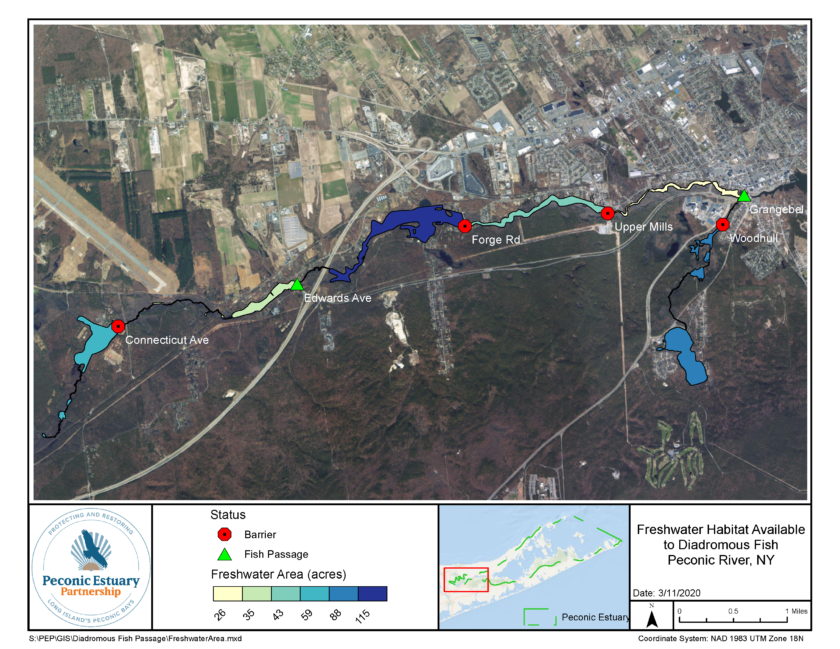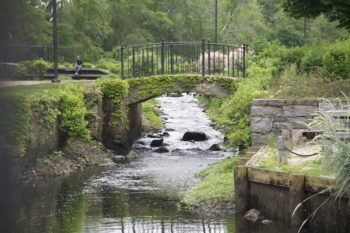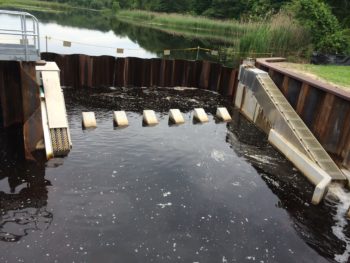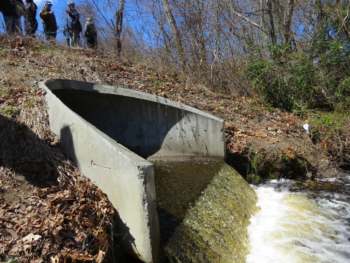Protecting & Restoring Long Island's Peconic Bays
The Peconic Estuary Partnership is working with its partners to restore critical freshwater spawning and maturation habitat for diadromous fish.
River herring is the collective term for two species of diadromous fish: alewife (Alosa pseudoharengus) and blueback herring (Alosa aestivalis). Diadromous fish are fish that migrate between fresh and ocean waters. River herring spend most of their life in the ocean but return to freshwater rivers, streams, and lakes to spawn. They provide many vital ecosystem services throughout their life cycle including filtering the water column and serving as prey for important commercial and recreational fish species, migratory birds, and mammals. River herring populations have been declining for the past century in part due migration barriers – dams and road culverts – that block access to important freshwater habitat.
Fish passage projects along the Peconic River will restore over 300 acres of habitat.
The Peconic River is the main source of freshwater to the Peconic Estuary. Until recently, the Peconic River had six dams along its length that prevented diadromous fish species from migrating up and downstream. In 2010, a fishway was built at the Grangebel Dam, and in 2016 another fish passage project was completed at the Edwards Avenue Dam. Together these fish passage projects open up 60 acres of spawning and maturation habitat for river herring. Construction of a third fish passage is planned at the Woodhull Dam on Little River, a tributary of the Peconic River, in the near future. By providing passage through, or around, these barriers on the Peconic River, river herring and other diadromous fish will be able to access critical habitat, thereby promoting the recovery of these diadromous fish species and improving biodiversity in the Peconic Estuary and marine ecosystem. All dams on the Peconic River, with the exception of the most upstream dam, are in some phase of river connectivity restoration. Efforts have been led by the PEP, partnering with NY State, Suffolk County, local governments, non-profit organizations and others. You can learn more about these projects below.

In 2010, a permanent “nature-like” fishway was built at the first barrier on the Peconic River, Grangebel Dam, opening up 25 acres of diadromous fish spawning and maturation habitat. The success of this project has helped to spur along other fish passage projects. Currently, a majority of the river herring population that uses the Grangebel fishway, 50,000-80,000 fish, ends up at Woodhull Dam on Little River, spawning below the dam each year in a stalled effort to reach upstream habitat. Fish also end up at Upper Mills Dam, the next major barrier on the main stem of the Peconic River.

In June 2016, an Alaska Steep Pass and American Eel Pass was constructed by the New York State Department of Environmental Conservation (NYSDEC) at Edwards Avenue dam, a structurally damaged NYSDEC owned dam. This fish passage will open up 35 acres of spawning and maturation habitat for diadromous fish. Fish cannot yet use this fish passage due to downstream dams at Upper Mills and Forge Road, but fish projects at these downstream dams are in the works.

The Woodhull Dam is the next major barrier to fish passage on the Little River, a major tributary to the Peconic River. Providing permanent fish passage at Woodhull Dam would create access to 95 acres of prime spawning habitat within Wildwood Lake. Wildwood Lake is located within preserved lands and would provide high quality, protected habitat. The Permitting Services for Construction of a Fish Passage at the Woodhull Dam is completed through Suffolk County Parks and funding for the construction of the dam has been secured through a NYSDEC Water Quality Improvement Project (WQIP) Grant and Suffolk County. PEP applied for these grants in partnership with Suffolk County Parks to fund the fish passage construction.

The Upper Mills Dam is the next major barrier to fish passage on the main stem of the Peconic River. A feasibility and alternative analysis for fish passage at the Upper Mills Dam was completed in 2011. PEP is currently contracting with L.K. Mclean Associates P.C. to complete the engineering design and permitting services for construction of a fish passage at the Upper Mills Dam. This project will open 40 acres of historic spawning and maturation habitat for diadromous fish.
Plans are underway to replace the structurally damaged Forge Road Dam and to construct a fish passage based on the Conceptual Habitat Restoration Design for Forge Road Dam completed with PEP funding in 2013. This project will open approximately 115 acres of historic spawning and maturation habitat for diadromous fish within the Peconic River.
Learn more about Habitat Restoration efforts in the Peconic Estuary here.
Sign up for News, Events and Information straight to your inbox.
